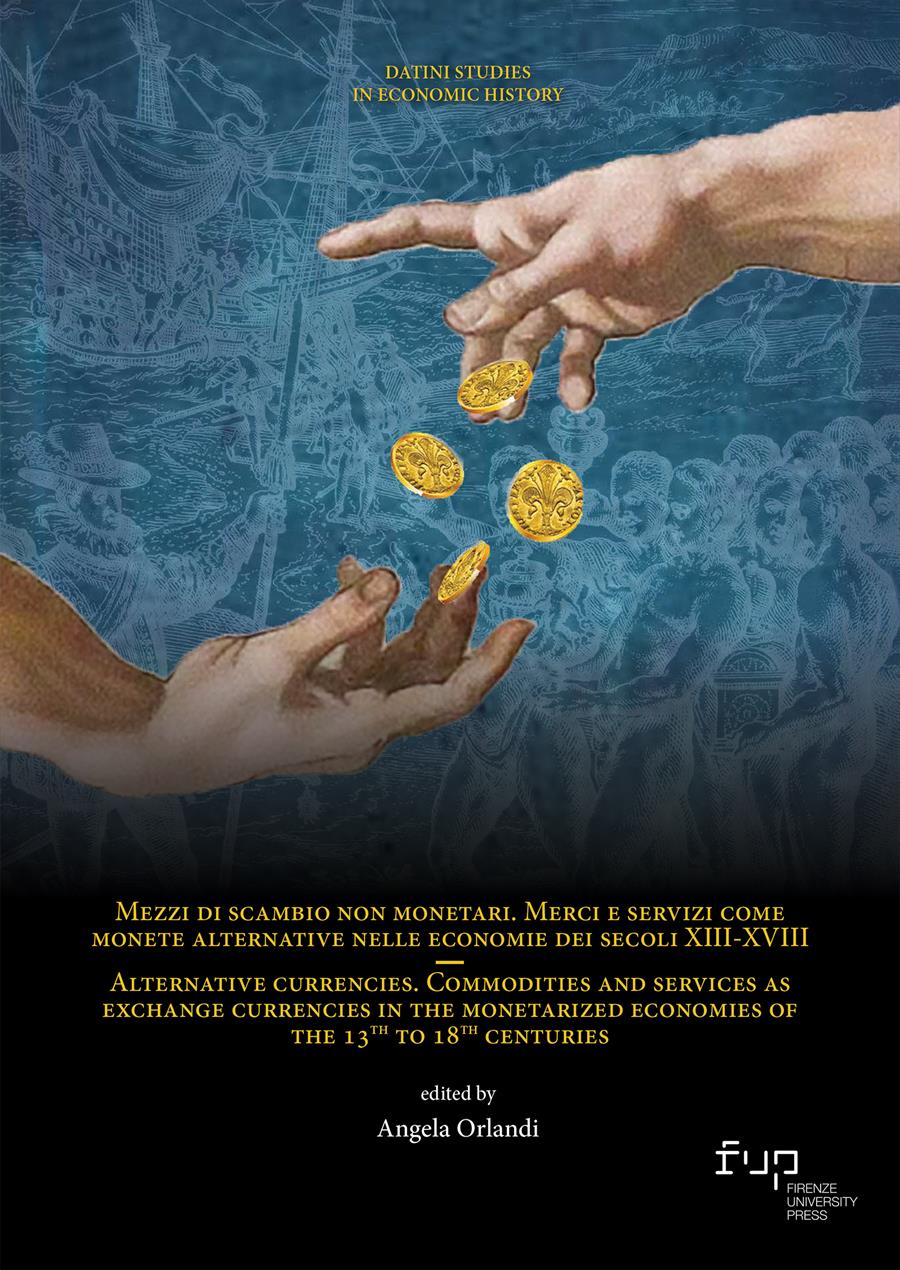An apparent paradox: wool as an alternative currency for merchants and weavers in Dubrovnik (Ragusa) in the 15th century
- Nenad Fejic
- © 2024 Author(s) |
- CC BY 4.0
- DOI: 10.36253/979-12-215-0347-0.20
This article examines the use of wool as an alternative currency in Dubrovnik in the first half of the 15th century. The actors of this practice were Catalan merchants who advanced wool to local weavers. In return, the weavers had to refund the credit by transforming the wool into fabrics. The quantity of fabrics returned was always greater than the quantity that could be produced from the wool received. This use of wool as an alternative currency corresponded to the mining prosperity in the Balkans. Silver, a precious metal, was exported by the Catalans, rather than being used to finance local wool production, which therefore had to resort to a local financing circuit, where wool, in the absence of silver currency, served as an alternative currency.
- Keywords:
- Dubrovnik,
- Catalans,
- wool,
- silver,
- currency,
- ,
University of the French West Indies and Guiana, France
- Battle-Gallart, Carmen. 1973. La crisis social y economica de Barcelona a mediados del siglo XV. Barcelona: CSIC-Departamento de Estudios Medievales.
- Bettarini, Francesco. 2012. La comunità pratese di Ragusa (1414-1434). Crisi economica e migrazioni colletive nel Tardo Medioevo. Firenze: Olschki.
- Bettarini, Francesco. 2012. “Mercanti fiorentinii ed artigiani pratesi a Ragusa (Dubrovnik).” In “Mercatura è arte”. Uomini d’affari Toscani in Europa e nel Mediterraneo Medievale, ed. Lorenzo Tanzini, and Sergiio Tognetti, 97-114, Roma: Viella.
- Bettarini, Francesco. 2016. “La giustizia mercantile nella Ragusa (Dubrovnik) basso medievale.” In Tribunali di mercanti e giustizia mercantile nel tardo Medioevo, ed. Elena Maccioni, and Sergio Tognetti, 29-50, Firenze: Olschki.
- Bettarini, Francesco, 2016 “I contratti di assunzione nella manufattura tessile ragusea.” Dubrovacki Anali 20: 53-59
- Carrère, Claude. 1967. Barcelone, centre économique à l’époque des difficultés 1380-1462, I-II : Paris-La Haye: Mouton.
- Cirkovic, Sima. 1981. “The production of gold, silver and copper in the central parts of the Balkans from the 13th to the 16th Century.” In Precious metals in the age of expansion, ed. Hermann Kellenbenz, 41-69. Stuttgart: Klett-Cotta.
- Cirkovic, Sima.1986. “Deux conjonctures dans l’industrie minière balkanique : XV-XVI siècles. » In Miniere e metallurgia secc. XIIIU-XVIII, Atti della settimana di studi in CD-rom, ed. Simonetta Cavaciocchi. Prato: Istituto Internazionale di Storia Economica “F. Datini”.
- Del Treppo, Mario. 1976. Els Mercaders Catalans i l’ expansio de la Corona Catalano-Aragones al segle XV. Barcelona: Curial.
- Fejic, Nenad. 1982-1983. “Dubrovcanin Benko Kotruljevic pred sudom kraljice Marije Aragonske u Barceloni.” Istorijski casopis, 29-30: 77.84.
- Fejic, Nenad. 1988. Spanci u Dubrovniku u srednjem veku. Beograd: Prosveta.
- Fejic, Nenad.1994. “Les Catalans à Dubrovnik et dans le bassin adriatique à la fin du Moyen Age, Anuario de estudios medievales , 24 : 429-452.
- Fejic, Nenad, 1996. “Les Espagnols à Dubrovnik.” In Les immigrants et la ville, insertion, intégration, discrimination (XIIe-XXe siècles), ed. Denis Menjot, et Jean-Luc Pinol, 83-90. Paris: L’Harmattan.
- Krekic, Barisa. 1976. “I mercanti e produttori toscani di panni di lana a Dubrovnik (Ragusa) nella prima metà del Quattrocento.” In Produzione, commercio e consumo dei panni di lana nei secoli XII-XVIII, ed. Marco Spallanzani, 707-14. Firenze: Olschki.
- Krekic, Barisa. 1979. “Italian creditors in Dubrovnik (Ragusa) and the Balkan Trade, Thiteenth through Fifteenth centuries.” In The dawn of modern banking, 241-54. New Haven: Yale University Press.
- Pinelli, Paola. 2006. Il Carteggio Marcovaldi (1401-1437) nell’Archivio di Stato di Prato. Roma: Ministero per i beni culturali e ambientali.
- Pinelli, Paola. 2013. Tra argento, granni e panni. Piero Pantella, un operatore italiano nella Ragusa del primo Quattrocento. Firenze: Firenze University Press.
- Tadic, Jorjo. 1974. “Jugoslavia e Paesi Balcanici: produzione e esportazione di lana.” In La lana come materia prima. I fenomeni della produzione e circolazione nei secoli XIII-XVII, ed. Marco Spallanzani, 291-97. Firenze: Olschki.
- Vlajinac, Milan. 1968. Recnik nasih starih mera-u toku vekova. Beograd: Srpska akademija nauka i umetnosti.
- Voje, Ignacij. 1976. Kreditna trgovina u srednjovekovnom Dubrovniku. Sarajevo : Akademija nauka i umjetnosti Bosne i Hercegovine.
Chapter Information
Chapter Title
An apparent paradox: wool as an alternative currency for merchants and weavers in Dubrovnik (Ragusa) in the 15th century
Authors
Nenad Fejic
Language
English
DOI
10.36253/979-12-215-0347-0.20
Peer Reviewed
Publication Year
2024
Copyright Information
© 2024 Author(s)
Content License
Metadata License
Bibliographic Information
Book Title
Mezzi di scambio non monetari. Merci e servizi come monete alternative nelle economie dei secoli XIII-XVIII / Alternative currencies. Commodities and services as exchange currencies in the monetarized economies of the 13th to 18th centuries
Editors
Angela Orlandi
Peer Reviewed
Number of Pages
592
Publication Year
2024
Copyright Information
© 2024 Author(s)
Content License
Metadata License
Publisher Name
Firenze University Press
DOI
10.36253/979-12-215-0347-0
ISBN Print
979-12-215-0346-3
eISBN (pdf)
979-12-215-0347-0
eISBN (xml)
979-12-215-0348-7
Series Title
Datini Studies in Economic History
Series ISSN
2975-1241
Series E-ISSN
2975-1195
